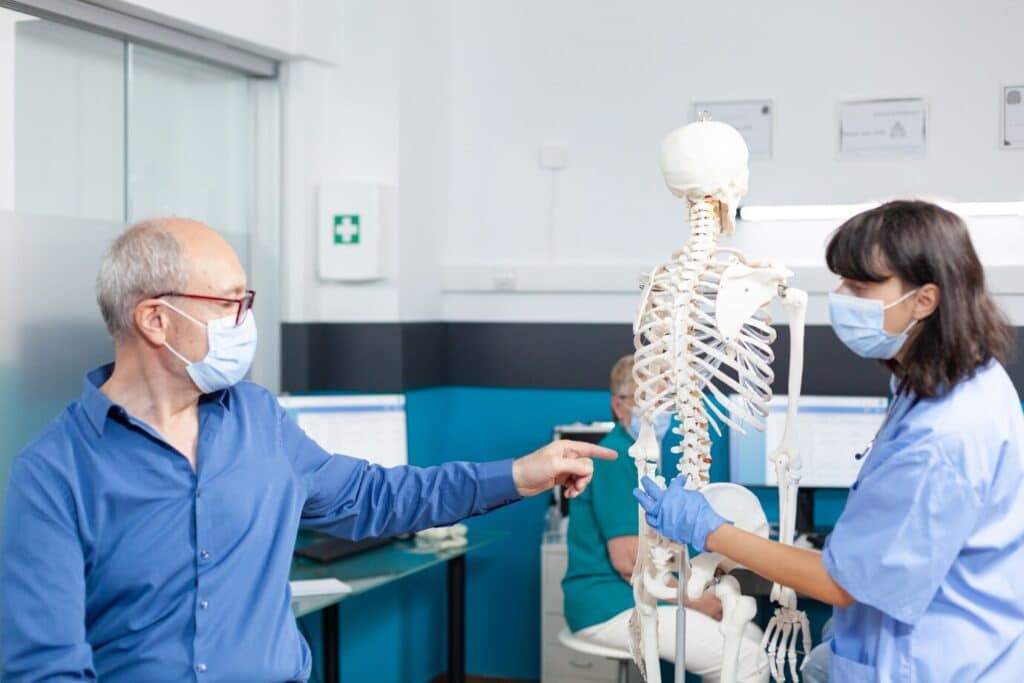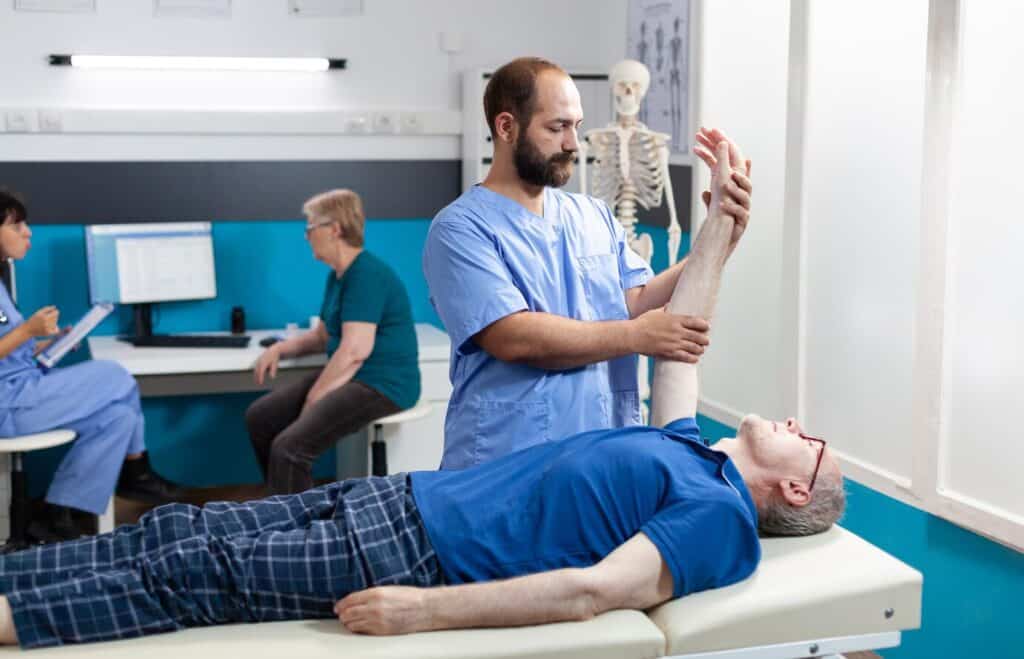Your bones naturally lose density as you age, making them more prone to fractures. But did you know that osteoporosis, a silent bone disease, progresses in four stages, each with its own set of characteristics? According to the National Health Service (NHS), osteoporosis is when the bones become weak and fragile, making them more susceptible to fractures. In this article by Westmont of Escondido, we’ll research the different stages of osteoporosis, from the early signs to the more severe symptoms, and explore how doctors diagnose and treat each stage. By understanding the progression of osteoporosis, you’ll be better equipped to take control of your bone health and reduce your risk of fractures.
Stage 1: Normal Bone Density
The first stage of osteoporosis is characterized by average bone density, where your body’s bone loss and formation are in balance. At this stage, you are not likely to experience any symptoms, and your bones are still strong and healthy.
Defining Normal Bone Density
To understand average bone density, it is essential to know that your body constantly breaks down old bone and replaces it with new bone tissue. In a healthy individual, this process occurs at a rate that maintains a stable bone density. According to the National Institute on Aging, at stage 1 of osteoporosis, bone loss and formation develop at the same rate, indicating average bone density.
Risk Factors for Osteoporosis
There are numerous risk factors for osteoporosis, and understanding them can help you take preventive measures. Thou should be aware of the following risk factors:
- Family history of osteoporosis
- Low calcium intake
- Lack of physical activity
- Smoking
- Excessive alcohol consumption
- Certain medical conditions, such as rheumatoid arthritis or lupus
- Long-term use of certain medications, such as corticosteroids
With a clear understanding of these risk factors, you can take steps to reduce your risk of developing osteoporosis. For instance, ensuring adequate calcium intake, engaging in regular exercise, and quitting smoking can help maintain healthy bones. Additionally, if you have a family history of osteoporosis, consulting with your doctor about early screening and preventive measures can be beneficial.

Risk Factors for Osteoporosis
Stage 2: Osteopenia
Now that we’ve covered the first stage of osteoporosis, let’s move on to the second stage, osteopenia.
What is Osteopenia?
What happens when your bone loss starts to outpace your bone formation? You enter the stage of osteopenia, where your bone mass or density is lower than usual for your age.
Symptoms and Diagnosis
Diagnosis of osteopenia typically involves a bone density scan, which measures the mass and strength of your bones. You may not experience any symptoms at this stage, and your bones are less likely to fracture.
Another important aspect of diagnosis is the T-score, which compares your bone mass to a typical young adult. A T-score between -1.0 and -2.5 indicates osteopenia, and your doctor may use a Fracture Risk Assessment Tool (FRAX) score to determine if you need treatment.
What Level of Care Do You Need?
Discover the level of care you or your family member requires.
Treatment Options for Osteopenia
Reducing your risk of developing osteoporosis is a crucial step in managing osteopenia. This may involve lifestyle changes, such as increasing calcium and vitamin D intake, exercising regularly, and quitting smoking.
A crucial aspect of treatment is early intervention. Addressing osteopenia early on can slow down bone loss and reduce your risk of fractures. Your doctor may also recommend medication to help strengthen your bones.
If you’re concerned about osteopenia or osteoporosis, it’s crucial to consult with a healthcare professional. At Westmont of Escondido, our team of experts can provide you with personalized guidance and treatment options. Contact us today at 760-737-5110 to learn more.
For more information on osteoporosis and its stages, check out our related articles:
- Is there a cure for osteoporosis?
- Are prunes beneficial for osteoporosis?
- What to know about glucocorticoid-induced osteoporosis
- Can strontium help to treat osteoporosis?
Recall understanding the stages of osteoporosis is crucial for effective management and prevention. Stay informed, and take control of your bone health today!
Stage 3: Mild Osteoporosis
Once again, at this stage, your bone loss is exceeding your bone growth, putting you at a higher risk of bone fractures. Although you may still not have any symptoms, a doctor is likely to diagnose you with osteoporosis.
Defining Mild Osteoporosis
Mildly weakened bones characterize mild osteoporosis. Your bone density has decreased at this stage, but you may not have experienced any fractures yet. A T-score of -2.5 or below indicates mild osteoporosis, and you may need treatment to prevent further bone loss and reduce your risk of fractures.
Fracture Risk Assessment
A Fracture Risk Assessment Tool (FRAX) score is used to determine the risk of fractures for individuals with mild osteoporosis. This tool considers various factors, including bone density, age, and medical history.
For instance, if you have a high FRAX score, your doctor may recommend treatment to reduce your risk of fractures. The FRAX score is an essential tool in determining the best course of treatment for individuals with mild osteoporosis.
Lifestyle Changes for Managing Mild Osteoporosis
Osteoporosis management involves making lifestyle changes to slow bone loss and reduce the risk of fractures. At this stage, it’s important to focus on exercises that improve balance and strength, such as weight-bearing exercises like walking or jogging.
Another crucial aspect of managing mild osteoporosis is ensuring you get enough calcium and vitamin D through your diet or supplements. A healthy diet rich in these nutrients can help support bone health and reduce your risk of fractures.
Stage 4: Established Osteoporosis
Many people with osteoporosis reach stage 4, also known as established osteoporosis, without realizing they have the condition until they experience a bone fracture. At this stage, the risk of bone fracture is higher, and due to severe bone loss, you may start to notice symptoms such as back pain, stooped posture, or height loss.
Characteristics of Established Osteoporosis
On average, people with established osteoporosis have a T-score of -2.5 or lower, indicating significant bone loss. They may also have experienced one or more fragility fractures, which can significantly impact their quality of life.
Managing Chronic Pain and Disability
Established osteoporosis can lead to chronic pain and disability, making it necessary to work with your healthcare provider to develop a comprehensive management plan. This may include physical therapy, pain management strategies, and assistive devices to help you maintain your independence.
For instance, your healthcare provider may recommend exercises to improve your balance and strength, reducing your risk of falls and fractures. They may also suggest using a cane or walker to help with mobility and relieve pain.

Managing Chronic Pain and Disability
Medication Options for Established Osteoporosis
Established osteoporosis often requires medication to slow down bone loss and reduce the risk of further fractures. Your healthcare provider may prescribe bisphosphonates, such as alendronate or zoledronic acid, which can help strengthen your bones and reduce the risk of vertebral fractures.
Osteoporosis medications can have significant benefits, but they may also have side effects. To ensure you get the most out of your treatment plan, discuss the risks and benefits with your healthcare provider and carefully follow their instructions.
Diagnosis
Remember that diagnosing osteoporosis typically involves a combination of physical examination, medical history, and diagnostic tests. Your doctor may recommend the following tests to determine if you have osteoporosis and assess the condition’s severity.
Bone Density Tests (DXA and QCT)
With a bone density test, your doctor can measure the density of your bones and compare it to the average bone density of a healthy young adult. Dual-energy X-ray absorptiometry (DXA) and quantitative computed tomography (QCT) are two standard bone density tests used to diagnose osteoporosis.
Blood Tests for Osteoporosis Markers
The density of specific proteins in your blood can indicate bone turnover, which can help your doctor diagnose osteoporosis. Blood tests may measure levels of osteocalcin, bone-specific alkaline phosphatase, or collagen crosslinks to assess bone formation and resorption.
It’s crucial to note that blood tests are not as accurate as bone density tests in diagnosing osteoporosis, but they can help monitor the effectiveness of treatment. Your doctor may use blood and bone density tests to understand your bone health better.
Imaging Tests for Fracture Detection
Imaging tests such as X-rays, computed tomography (CT) scans, or magnetic resonance imaging (MRI) can help identify fractures or bone deformities when diagnosing osteoporosis. These tests are beneficial in detecting vertebral compression fractures, which can be a sign of osteoporosis.
The results of these imaging tests can help your doctor determine the severity of osteoporosis and develop an appropriate treatment plan. Additionally, imaging tests can help monitor the disease’s progression and treatment effectiveness over time.
Treatment and Management
Despite the severity of osteoporosis, various treatment and management options are available to help slow down bone loss, reduce the risk of fractures, and improve overall bone health.

Treatment and Management
Lifestyle Modifications for Osteoporosis Prevention
Lifestyle modifications are imperative to reduce the risk of developing osteoporosis. These include maintaining a healthy diet rich in calcium and vitamin D, engaging in regular exercise such as weight-bearing and resistance training, quitting smoking, and limiting alcohol consumption. These changes can help promote bone growth and reduce bone loss.
Medications for Osteoporosis Treatment
Modifications to your medication regimen can also be crucial in managing osteoporosis. Your doctor may prescribe bisphosphonates, hormone replacement therapy, or osteoporosis-specific medications like denosumab or romosozumab to help slow down bone loss and reduce the risk of fractures.
Management of osteoporosis through medication requires careful consideration of your individual needs and health status. Your doctor will work with you to develop a personalized treatment plan that considers your medical history, lifestyle, and other factors. By adhering to your medication regimen and making lifestyle modifications, you can effectively manage your osteoporosis and reduce the risk of fractures.
Alternative Therapies for Osteoporosis Management
Treatment of osteoporosis is not limited to conventional medications. Alternative therapies such as acupuncture, massage, and yoga can help improve bone density and reduce the risk of fractures. These therapies can also help manage osteoporosis-related pain and improve overall quality of life.
For instance, yoga has been shown to improve balance, flexibility, and strength, reducing the risk of falls and fractures. Acupuncture, on the other hand, can help stimulate bone growth and reduce inflammation. While these alternative therapies may not be suitable for everyone, they can be a valuable addition to your osteoporosis management plan when used in conjunction with conventional treatments.
At Westmont of Escondido, we understand the importance of comprehensive osteoporosis management. Our team of healthcare professionals is dedicated to providing personalized care and support to help you manage your osteoporosis and improve your overall health. Contact us today at 760-737-5110 to learn more about our services and how we can help you navigate the different stages of osteoporosis.
Find Where You Belong
Dive into the vibrant life our Westmont communities have to offer.
Final Words
Drawing together the understanding of the different stages of osteoporosis, it’s clear that this silent bone disease can progress silently until it’s too late. However, by recognizing the four stages – from bone loss and formation balance to severe bone loss and fractures – you can take proactive steps to prevent or manage osteoporosis. Remember, a bone density scan is the best way to diagnose osteoporosis, and treatment options are available to slow bone loss and reduce fracture risk. For more information on osteoporosis, visit Osteoporosis – Symptoms and causes. If you’re concerned about your bone health, don’t hesitate to contact Westmont of Escondido at 760-737-5110, located in Escondido, CA, for expert guidance and support.









